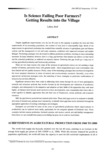Is Science Failing Poor Farmers? Getting Results into the Village
JIRCAS international symposium series
| ISSN | 13406108 |
|---|---|
| 書誌レコードID(総合目録DB) | AA1100908X |

本文フルテキスト
intlsymp-12_157-164.pdf632.77 KB
Despite significant improvements over the last 40 years in the capacity to produce the food and fibre requirements of an increasing population, the number of rural poor is unacceptably high. Much of the improvement in agricultural production has resulted from scientific advances in germplasm, pest and disease control, and the management of soil and water resources, combined with improved transport and market linkages. Technology packages were developed to address production problems, resulting in many astounding successes. In many situations, however, there is a large gap between what farmers can achieve on their farms and the potential production, as achieved on research stations. Reducing this gap would go a long way to solving agricultural production and food security problems.
There are two main reasons why some of the advances in agricultural science are not reaching a large number of farmers, particularly those with greatest needs - those marginalized poor rural communities who have limited and low quality resources. Firstly, many of the technology packages have not been developed for the more marginal situations in terms of natural and socioeconomic resources. Secondly, even when appropriate production strategies exist, the matching of these strategies to particular combinations of resources has not been effective.
Significant advances have been made in addressing these issues through the use of more participatory research and extension methods that involve farmers in the development and validation of production strategies, and subsequently in the adaptation and adoption on their fields of the approaches they rank most highly. As farmers have become more involved in these developments, rural communities have been able to work together to identify approaches that suit their sets of biophysical, social, political, and economic resources.
Still, the gap between potential and realized yield exists. These yield gaps need to be analysed to identify new areas of research and, perhaps more importantly, to identify those gaps that can be minimized through the appropriate application of existing technologies and strategies.
Examples are provided of some of the areas of agricultural production where improvements in productivity can be achieved most easily, particularly for the marginal uplands of Southeast Asia. These examples include cassava production, livestock systems, soil erosion control, and soil fertility management. From these we can conclude that science is not failing the poor, but it could do much better.
There are two main reasons why some of the advances in agricultural science are not reaching a large number of farmers, particularly those with greatest needs - those marginalized poor rural communities who have limited and low quality resources. Firstly, many of the technology packages have not been developed for the more marginal situations in terms of natural and socioeconomic resources. Secondly, even when appropriate production strategies exist, the matching of these strategies to particular combinations of resources has not been effective.
Significant advances have been made in addressing these issues through the use of more participatory research and extension methods that involve farmers in the development and validation of production strategies, and subsequently in the adaptation and adoption on their fields of the approaches they rank most highly. As farmers have become more involved in these developments, rural communities have been able to work together to identify approaches that suit their sets of biophysical, social, political, and economic resources.
Still, the gap between potential and realized yield exists. These yield gaps need to be analysed to identify new areas of research and, perhaps more importantly, to identify those gaps that can be minimized through the appropriate application of existing technologies and strategies.
Examples are provided of some of the areas of agricultural production where improvements in productivity can be achieved most easily, particularly for the marginal uplands of Southeast Asia. These examples include cassava production, livestock systems, soil erosion control, and soil fertility management. From these we can conclude that science is not failing the poor, but it could do much better.
| 作成者 | Rod Lefroy |
|---|---|
| 公開者 | Japan International Research Center for Agricultural Sciences |
| オンライン掲載日 | |
| 号 | 12 |
| 開始ページ | 157 |
| 終了ページ | 164 |
| 言語 | eng |
